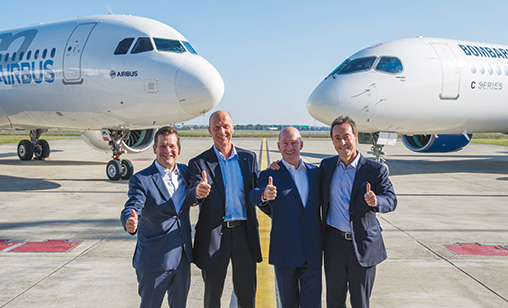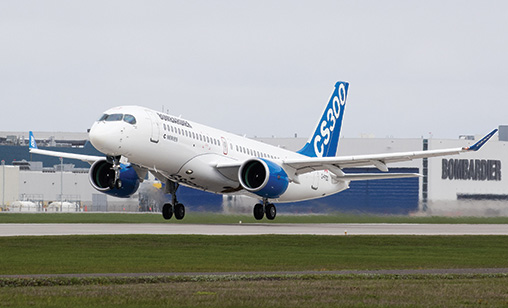News Backgrounder
Bombardier deal adds heat to subsidy battles
Airbus’ surprise announcement last month that it would take control of Bombardier’s C Series jet program stunned industry observers, including Boeing. Chief correspondent, Tom Ballantyne, reports on the impact the investment will have on the world’s aircraft manufacturers.
November 1st 2017
“The stunning Airbus-Bombardier partnership for the C Series program guarantees the future of the new airplane, kills off the A319 and thrusts a big stick up Boeing’s tailpipe,” said Scott Hamilton, the founding principal of a North American aviation consultancy, after it was announced that the Toulouse-headquartered manufacturer is buying 50.01% of the Canadian rail and aircraft builder. Read More »
Certainly, the Airbus investment revives the fortunes of the new aircraft type, particularly in Asia where the C Series’ only customer is Korean Air’s with an order of 10 of the planes.
 |
Just as significant is speculation Boeing may counter Airbus by forming closer ties with Brazilian aircraft manufacturer, Embraer. Teal group analyst, Richard Aboulafia, said: “the world has two top-tier air framers and two second-tier air framers. Airbus and Bombardier are now allies. This greatly increases the likelihood of a stronger Boeing-Embraer alliance as a response.”
Boeing and Embraer already work together on runway safety and alternative jet fuels. Their partnership has deepened in recent years to include Boeing’s commitment to joint sales and support of Embraer’s KC-390 military aircraft.
Boeing has made it clear it was not happy with the Airbus buy in of the C Series programme. It accused Airbus and Bombardier of attempting to circumvent a decision by President Donald Trump’s administration to hit the C Series aircraft with import duties of 300%.
The duty imposition followed Boeing’s complaint that Bombardier had sold 75 C Series jets to Delta Air Lines for “absurdly low prices”. The Seattle plane maker said the Airbus-Bombardier agreement is a “questionable deal between two heavily state-subsidized competitors to skirt the recent findings of the U.S. government. Our position remains that everyone should play by the same rules for free and fair trade to work”.
The terms of Airbus’ majority investment included a new C Series final assembly line at Airbus’ plant in Mobile, Alabama, where it now assembles A320s. Whether that decision would allow the partners to avoid the hefty tariff was not clear at press time. A U.S. government fact sheet on the matter said the duties would apply to C Series jets “regardless of whether they enter the United States fully or partially assembled”.
The October agreement was concluded very quickly, given the complexity of negotiations. Airbus chief executive, Tom Enders, said discussions with Bombardier had started in August.
There had been reports the Canadian company had been in touch with a small group of Chinese state-owned enterprises about a C Series holding, including the Commercial Aircraft Corporation of China, or COMAC. The Mainland aerospace manufacturer has built China’s first single aisle commercial jet, the C919. Both COMAC and Bombardier declined to comment.
| 'Ranging from 100 to 150 seats, the C Series is highly complementary to Airbus’ existing single aisle aircraft portfolio, which focuses on the higher end of the single-aisle business (150-240 seats).' |
For Bombardier, the Airbus partnership was a massive boost to the future of the C Series. Bombardier reportedly spent more than $6 billion in development costs on the jet and had to rely on Canadian government assistance to complete the project.
Apart from the Delta deal of 18 months ago, Bombardier has not received a major order for the aircraft. Bombardier chief executive, Alain Bellemare, said the joint venture would double the value of the C Series program, to $4 billion.
The company’s chief financial officer, John Di Bert, said Bombardier had agreed to provide $350 million for the C Series in the first 12 months after the close of the deal, with completion of the transaction expected in the second half of 2018.
It is hoped the new arrangement will jump start orders for the jet in the Asia-Pacific. Founder of Malaysia-based Endau analytics, Shukor Yusof, said airlines in the region have held back from placing orders for the Canadian plane because Bombardier’s weak financial position placed the C Series program in jeopardy.
“Potential buyers of the C Series are given comfort now that Airbus will be a major shareholder. It will ensure stability in the program,” he said. The aircraft also will benefit from Airbus’ powerful sales network and support throughout the region.
Bombardier head of structured finance, Marc Meloche, said several Chinese lessors, who were largely looking for sale-and-leaseback opportunities, had issued term sheets in support of C Series deliveries.
New Mainland rules that require Chinese airline startups to operate at least 25 smaller regional jets before graduating to bigger aircraft have fueled hopes of Chinese demand for the C-Series.
Under the new shared ownership, Airbus will provide procurement, sales and marketing and customer support expertise to the C Series Aircraft Limited Partnership (CSALP), the entity that manufactures and sells the C Series.
 |
To close the deal, Airbus will acquire a 50.01% interest in CSALP and Bombardier and Investissement Québec (IQ) will own approximately 31% and 19%, respectively. Airbus pointed has out the single aisle market represented 70% of future global aircraft demand.
“The world class sales, marketing and support networks Airbus brings to the venture are expected to strengthen and accelerate the C Series’ commercial momentum. Additionally, Airbus’ supply chain expertise is expected to generate significant C Series production cost savings,” Airbus said.
Airbus’ Enders said: “The C Series, with its state-of-the-art design and great economics, is a great fit with our existing single-aisle aircraft family and rapidly extends our product offering into a fast-growing market sector.
“I have no doubt our partnership with Bombardier will boost sales and the value of this program tremendously. Not only will this partnership secure the C Series and its industrial operations in Canada, the U.K. and China, but it also will bring new jobs to the U.S. Airbus will benefit from strengthening its product portfolio in the high-volume single-aisle market, offering superior value to our airline customers worldwide.”
The agreement was an about-face for Enders. He halted negotiations for a tie up with Bombardier two years ago. Analysts viewed the deal as a triumph for Airbus that turns the C Series from an attack on U.S. jobs, as Boeing has complained, to a job creator in Alabama, a key Republican state.
It is believed the arrival of the C Series at Airbus signaled the end of the line for the A319, which has not posted a sale for five years.Airbus is expected to pressure the key B737 MAX 8 model by squeezing it from below with the C Series and from above with the popular A321neo.
The joint venture gives Airbus access to a technologically advanced, fuel-efficient design that could form the basis of its challenge in the highest volume jetliner sector for years to come, saving billions in development costs.
It will put pressure on Boeing, which is only now embarking on plans for a new short-haul model. It has been estimated that piggy-backing on the C Series could save Airbus $10 billion in development costs.
Enders said it was too early to speculate on whether the plane would form the basis for the company’s next short-haul offering, but he acknowledged it was likely Airbus would take cues from the Canadian aircraft’s cockpit design and advanced aeronautics.
Regardless of the development boost for Airbus, the near-term ramifications for Boeing may be severe, with Airbus now able to bundle the C Series, which typically seats 108 to 130 passengers, and the larger A320 into a single offering.
Also it should not forgotten that China’s C919 is on the horizon and new narrow bodies from Russia and Japan will eventually join the battle to win orders in a market worth some $125 billion a year.